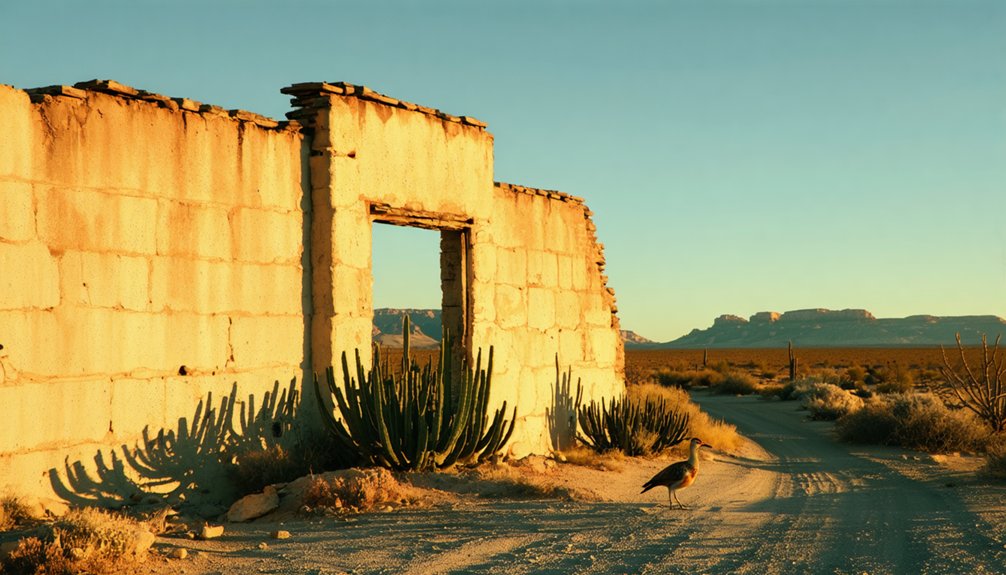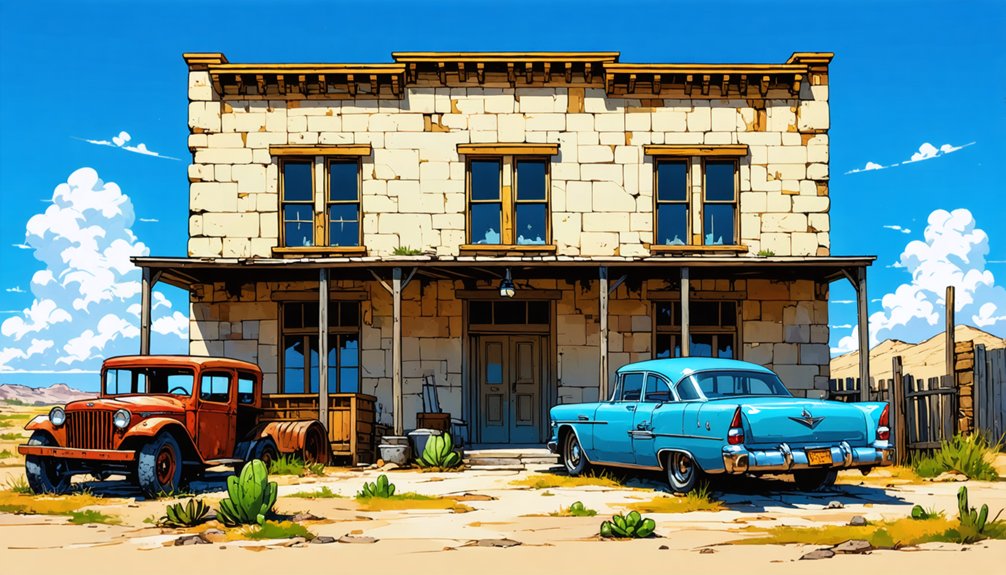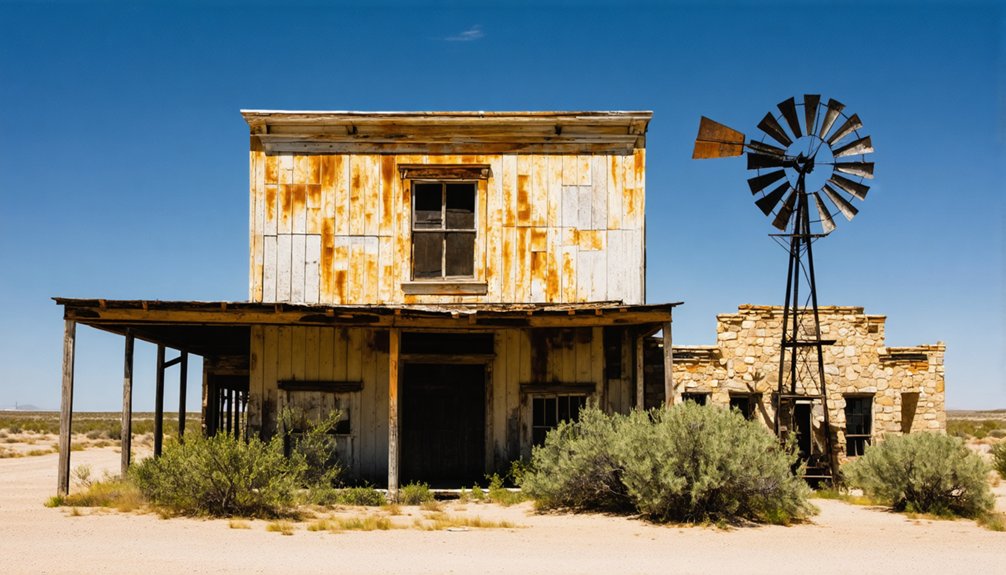You’ll find Langtry, Texas nestled along the Rio Grande, where Judge Roy Bean dispensed frontier justice from his Jersey Lilly Saloon between 1882 and 1903. Originally established as Eagle Nest railroad camp, this desert settlement grew into a Wild West town complete with a post office and businesses. Today, you can explore Bean’s preserved courthouse-saloon, visit the museum displaying his artifacts, and discover dramatic limestone cliffs overlooking the river. The town’s rugged landscape holds countless stories of outlaws, lawmen, and frontier life.
Key Takeaways
- Langtry transformed from a bustling railroad town established in 1882 to a near-ghost town after the railroad’s diminishing importance.
- Judge Roy Bean’s famous Jersey Lilly Saloon and courthouse remains preserved as a tourist attraction in the mostly-abandoned settlement.
- The town’s population drastically declined from its peak during railroad days to fewer than 20 current residents.
- US Highway 90 brings visitors to explore the historic buildings and museum featuring Judge Bean’s frontier justice legacy.
- The original railroad camp structures have largely disappeared, leaving only a few historic buildings and desert landscape.
From Railroad Camp to Desert Settlement
Three significant events marked Langtry’s beginnings in 1882: its establishment as Eagle Nest grading camp by Southern Pacific Railroad, the arrival of Chinese railroad crews under George Langtry’s supervision, and the Torres family’s essential water supply agreement.
The convergence of railway ambition, immigrant labor, and local resources shaped Langtry’s transformation from wilderness to thriving settlement in 1882.
You’ll find Langtry’s origins deeply rooted in railroad construction, as Southern Pacific placed stops every 15 miles to supply water for steam locomotives. The camp took its name from Eagle Nest Creek, known for its limestone cavern where golden eagles nested. Similar to other disambiguation pages, multiple historical references contributed to the town’s naming and development.
When immigrant workers arrived under George Langtry’s leadership, the settlement adopted his name and began transforming from a temporary camp into a permanent town. By 1884, you’d have seen a proper post office and growing businesses, despite the harsh desert conditions. The town soon became notorious for its lawlessness until Judge Roy Bean arrived to establish order.
The settlement flourished as ranchers moved in, raising sheep and goats around the essential rail stop.
The Legend of Judge Roy Bean
A weathered saloon door in Langtry marked the beginning of Judge Roy Bean‘s legendary rule as “the Law West of the Pecos” in 1882.
Inside his Jersey Lilly saloon, you’d find this Kentucky-born Confederate veteran dispensing his unique brand of frontier justice, often with a six-shooter at his side. Born in Mason County, Kentucky, Bean left his home state in 1847 to forge his path in the untamed West.
Bean’s legacy grew through his unorthodox court rulings, from fining dead men to staging the famous Fitzsimmons-Maher boxing match on a Rio Grande sandbar to skirt Texas law. He often helped the downtrodden despite his gruff exterior, spending his final days aiding the poor from his front porch.
Though lacking formal legal training, he maintained order in this lawless territory through a mix of practical enforcement and theatrical flair.
Even after electoral defeats, he continued wielding his judicial authority unofficially.
Today, his saloon stands as a monument to a time when justice meant whatever Judge Bean declared it to be.
Life at The Jersey Lilly Saloon
If you’d visited The Jersey Lilly Saloon in the 1880s, you would’ve found Judge Roy Bean presiding over his makeshift courtroom where pool tables doubled as sleeping quarters for his children and an oak tree outside served as the jail.
You could’ve ordered whiskey while watching Bean dispense his unique brand of frontier justice, keeping all collected fines for himself and often staging mock hangings rather than executing real ones. Despite his harsh reputation, Bean showed a softer side by providing Christmas gifts to local children.
The saloon drew both railroad workers and locals who gathered for drinks, gambling, and Bean’s theatrical court rulings, making it the social heart of this harsh Pecos River outpost. Bean named his beloved saloon after actress Lillie Langtry, whom he deeply admired though never met.
Daily Life and Business
Life at The Jersey Lilly Saloon exemplified the complex blend of frontier justice and social gatherings from 1882 to 1903, where Judge Roy Bean‘s unique approach to law enforcement shaped daily activities.
You’d find the saloon bustling with railroad workers and locals, while Bean’s daily routines included hearing cases and collecting fines that conveniently matched the accused’s cash on hand. Bean’s reputation for unusual justice included charging $5 for weddings and conducting all ceremonies with a grim final blessing. Rather than hanging criminals, he often put them to work improving the town.
The saloon’s community roles extended beyond drinking and socializing. Bean’s children made their home there, with his youngest son sleeping on the pool table.
Outside, an oak tree served as the makeshift jail, where offenders who couldn’t pay fines were chained.
The establishment’s dual purpose as courthouse and social hub created a distinctive atmosphere where justice, business, and pleasure intertwined in true frontier fashion.
Bean’s Court in Session
Running his court sessions from behind the saloon bar, Judge Roy Bean established The Jersey Lilly as the “Law West of the Pecos” from the 1880s until 1903.
His courtroom antics included charging fines he’d pocket himself and refusing to submit penalties to the state. You’d find no formal jail here – just a heavy log chain attached to an oak tree outside for those who couldn’t pay up. The money from these fines often went toward community needs, like providing proper burials for the dead.
Bean’s brand of frontier justice meant swift verdicts delivered anywhere in the saloon, even on the porch. He’d stage mock hangings to intimidate offenders or tie them to stakes under the hot sun.
Inside the Jersey Lilly, you’d witness a unique blend of legal proceedings and social gatherings, where local ranchers, railroad workers, and travelers mixed freely while Bean dispensed his peculiar form of desert law.
Drinks and Desert Justice
While Judge Roy Bean‘s courtroom shared space with his saloon, The Jersey Lilly operated as a profitable drinking establishment from 1882 to 1903.
You’d find Bean’s shrewd business practices on full display, from withholding customer change until he could levy a fine for their complaints to keeping every cent of the fines he collected.
After competitors attempted whiskey sabotage by tainting his stock with kerosene, Bean only grew more determined to maintain control.
- You’d witness staged hangings designed to intimidate wrongdoers
- You’d see convicts chained to the oak tree “jail” outside
- You’d watch courtroom theatrics as Bean matched fines to the exact amount in offenders’ pockets
- You’d find yourself working in town or tied to a stake in the sun if you couldn’t pay your fine
Desert Beauty and Natural Surroundings

As you gaze across Langtry’s rugged terrain, you’ll spot hardy mesquite trees and creosote bushes dotting the arid Chihuahuan Desert plains.
Rising above the desert floor, dramatic mesas and rocky outcrops provide stunning vantage points over the winding Rio Grande and its steep cliff edges. The carefully maintained native plants garden offers visitors a close-up look at desert flora.
The stark landscape bursts into color when seasonal wildflowers bloom after rare desert rains, complementing the year-round presence of agaves and prickly pear cacti that thrive in these harsh conditions.
Desert Flora Showcase
Despite its rugged desert terrain, Langtry’s natural surroundings showcase a stunning variety of native flora adapted to the harsh Chihuahuan Desert climate.
You’ll discover resilient plants that have mastered desert survival, from the delicate desert blooms of Mexican Evening Primrose to the towering Mesquite with its deep-reaching roots. These native adaptations create a mesmerizing display throughout the seasons.
- Watch Desert Zinnia’s bright flowers emerge from needlelike leaves, defying the scorching heat
- Witness Rio Bravo® Sage burst with lavender blooms after summer rains
- Marvel at Agave lecheguilla’s bold rosettes dotting the landscape
- Explore diverse Yucca species standing sentinel across the desert plains
The region’s succulents, shrubs, and flowering plants paint a vivid portrait of nature’s tenacity in this untamed Texas landscape.
Rugged Landscape Features
Perched along the Rio Grande’s dramatic cliffs, Langtry’s rugged terrain showcases the raw beauty of Southwest Texas’s Chihuahuan Desert.
You’ll find yourself surrounded by steep limestone formations that drop sharply to the river below, where Eagle Nest Canyon reveals ancient caverns carved high into the weathered canyon walls.
Desert erosion and tectonic forces have sculpted this untamed landscape, creating deep fissures and rocky outcrops that tell tales of geological drama.
The windswept sandstone features bear witness to nature’s patient artistry, while the Rio Grande’s persistent flow has carved deep channels through the borderlands.
You’ll discover how these natural barriers shaped historical pathways, from Native American crossings to railroad routes, leaving their mark on this fierce frontier landscape.
Preserving the Law West of the Pecos
When Texas Rangers and county commissioners appointed Roy Bean as Justice of the Peace in 1882, they established a essential legal presence in Langtry’s untamed frontier.
Bean’s unconventional brand of frontier justice operated from his saloon, the Jersey Lilly, where he’d blend legal traditions with his own colorful interpretations of the law.
You’ll find these enduring elements of Bean’s legacy in Langtry:
- A unique courthouse-saloon where justice met Western hospitality
- Blank warrants carried to deliver swift verdicts on the spot
- A six-shooter backing every judicial decision
- Rough but necessary order in a lawless territory
The arrival of the railroad in 1883 brought more outlaws and gamblers, making Bean’s presence critical.
While criticized for his methods, he maintained stability in a region where Fort Stockton’s courts were too distant to serve effectively.
Modern Tourism in a Historic Frontier Town

Today’s travelers following US Highway 90 through West Texas can explore one of America’s most authentic frontier justice sites in Langtry.
You’ll find the Jersey Lily Saloon and courthouse, where Judge Roy Bean once dispensed his unique brand of frontier justice, standing as a symbol of heritage preservation.
At the small museum, you can examine Bean’s personal artifacts, including his handcuffs and walking stick.
The visitor center provides modern amenities and local information while maintaining the town’s historic character.
For the best tourist experiences, combine your Langtry visit with trips to nearby ghost towns and archaeological sites.
The remote desert setting, dramatic cliff views, and proximity to the Rio Grande create an authentic atmosphere that’ll transport you back to the wild days of the American frontier.
Frequently Asked Questions
What Happened to Judge Roy Bean’s Personal Belongings After His Death?
Of Judge Bean’s legacy, 90% of his personal possessions went to his heirs, who sold them with his buildings to the Babbs. Today you’ll find some artifacts preserved at the museum in Langtry.
Are There Any Living Descendants of Original Langtry Settlers Still Residing Here?
You won’t find verified descendant lineage among modern residents in Langtry today. While some Torres family descendants may live elsewhere in Val Verde County, there’s no confirmation of original settlers’ families remaining here.
What Was the Highest Recorded Population of Langtry in Its History?
Ever wonder about peak population trends in old frontier towns? You’ll find Langtry’s historical significance topped out at 200-300 residents during the 1930s, when it thrived as a bustling ranching hub.
Can Visitors Stay Overnight in Langtry, and Where’s the Nearest Lodging?
You can’t stay overnight in Langtry itself. Your nearest local accommodations are in Comstock (5 miles away), with camping and hotels available. For full amenities, head to Del Rio, 35 miles east.
Does the Town Maintain Any Historical Records From Judge Bean’s Court Cases?
Poring through present-day Langtry, you won’t find formal court records from Bean’s cases. The town doesn’t maintain historical archives, with most knowledge coming from newspapers and folklore rather than official documents.
References
- https://www.onlyinyourstate.com/experiences/texas/abandoned-and-reclaimed-by-nature-tx
- https://en.wikipedia.org/wiki/Langtry
- https://jollyoutlaw.com/2024/11/langtry-ghost-town/
- https://www.americansouthwest.net/texas/langtry/index.html
- https://www.austinchronicle.com/columns/2020-03-13/day-trips-langtry-texas/
- https://www.youtube.com/watch?v=4ePO5HWJvIw
- https://www.tshaonline.org/handbook/entries/langtry-tx
- https://www.texasescapes.com/TOWNS/Texas_ghost_towns/Langtry_Texas/Langtry_Texas.htm
- https://www.legendsofamerica.com/tx-langtry/
- https://authentictexas.com/law-west-of-the-pecos/



